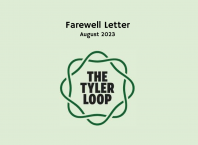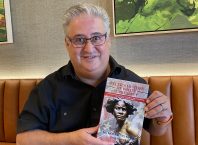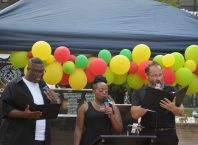
Tyler’s population has been increasing for over 20 years. According to United States Census data, the city’s population was 96,900 in 2010. By 2020, the population had increased to 105,995, and preliminary estimates brought it to 107,192 last year.
These changes have unfolded over the years, all the while climate and economic crises emerged alongside them.
Tyler and every other community on this planet are adapting to these challenges, but the question remains: Will it be enough?
Sustainability: a universal struggle

New Hope Energy, a Tyler-based company, broke ground on a recycling center in the city at 1775 East Duncan St. in 2018. According to the company, it is the first facility to recycle plastics via a process called pyrolysis. An expansion to the plant is expected to start next year, becoming the largest facility of its kind in the world once it is completed, according to New Hope.
Currently, the vast majority of plastic waste in the U.S. is not sustainably dealt with. According to the Environmental Protection Agency, 35.7 million tons of plastic waste were produced in the U.S. in 2018. Twenty-seven million tons were sent to landfills, and an additional 5.6 million tons were burned, releasing toxins into the atmosphere. Only 3 million tons were recycled.
Access to recycling is another significant hurdle to achieving sustainable consumption. According to the Solid Waste Association of America, 45 percent of Americans do not have access to curbside recycling, many of whom live in rural communities.
East Texas is one such unfortunate example. Only Tyler and Longview have elective programs for curbside recycling according to the Texas Commission on Environmental Quality. Beaumont discontinued its program in 2019.
New techniques cause for hope?

Pyrolysis is a relatively new technique seeking to solve issues surrounding single-use plastics. The process takes plastics previously considered unrecyclable and processes them into reusable feedstock.
According to Tom Sheehy, New Hope’s director of sales, marketing and feedstock, the company’s roots trace back to 2010, when founder Johnny Combs began tinkering with pyrolysis.
By 2013, Combs had found success. Prior to Combs, pyrolysis had been primarily used to create fuels. However, New Hope has adapted the process to further plastic generation, according to TotalEnergies, one of New Hope’s corporate partners.
New Hope and its partners claim this will help create a circular economy, where waste never reaches landfills.
According to Sheehy, the operation will have “no impact on the environment.” Additionally, the facility’s expansion and operation will have no emissions or impact on watersheds or habitats.
The facility is scheduled to be completed by 2022 and is expected to process 150,000 tons of plastic each year. Per Sheehy, plastics will be sourced from “recycling partners, industrial consumers, consumer package manufacturers and retail distribution centers” outside of East Texas.
Partnerships cause for concern?

Thus far, New Hope has attracted partnerships from far and wide for its products. Among them are Dow and S&B, all of which process petroleum products and other chemicals.
As of last year, Dow is the third largest chemical company in the world, according to Chemical and Engineering news. Dow’s history has had its share of controversy. Until 1969, Dow produced napalm infamously used in Vietnam. Dow also produced Agent Orange, a toxic defoliant known to cause birth defects and illness in those exposed.
In 2007, Dow settled with the EPA after chemical contamination in Michigan’s Tittabawassee River was traced back to one of their plants. People who lived and fished on the river tested for elevated levels of dioxin, a carcinogenic compound.

Dow also settled in a Supreme Court case centered on price-fixing domestically, according to Reuters. Additionally, the corporation faces allegations for failing to clean up contamination in India and of fraud in cases concerning pesticide pollution in Nicaragua.
According to PRNewswire, New Hope signed an agreement to provide Dow with pyrolysis oil feedstock to produce “circular plastics.”
S&B claims to be one of the country’s largest engineering, procurement and construction firms. Among its main clients are Chevron Phillips. In 2014, S&B constructed a 1-hexene unit at Chevron’s Cedar Bayou plant in Baytown, Texas. According to the Houston Chronicle, the machinery allows for increased production of polyethylene, which is used to create plastics.
In June 2021, S&B won a contract to build another 1-hexene unit at another CP facility in Old Ocean, Texas. Both in Baytown and Old Ocean, Chevron has been subjected to routine regulatory action by the EPA.

S&B also played a role in shaping Texas politics. Since 2015, the corporation donated $302,000 to Governor Greg Abbott, per Transparency USA. Abbott has famously said he would stand against climate-centric policy, according to the Texas Tribune.
Despite their connections to fossil fuels, Dow and S&B appear to be attempting to adapt to the climate crisis. Dow has publicly claimed it will become carbon neutral by 2050, according to C&EN.
Likewise, S&B has claimed they are aiding in the energy transition process by delivering “streamlined solutions focused on renewable fuels, circular economy, hydrogen and carbon capture use and storage (CCUS).”
According to Sheely, New Hope’s partnerships with these corporations are “helping them reach sustainability goals.” Additionally, New Hope received an International Sustainability and Carbon Certification, certifying the circular pyrolysis oil they produce is sustainable.
Sheehy said the facility will employ locals for construction and permanent staffing. However, East Texans will need to look elsewhere for their recycling needs, as the facility will not be open for public drop-off.
David A. Harrison is a Tyler native and a 2021 graduate of the University of Texas at Tyler. With a background in political science, Harrison uses his experience in research and policy to cover environmental and socioeconomic issues locally and abroad. Born into a working-class family, Harrison faced unhousedness and poverty in his childhood and adolescence. Ultimately, he plans on pursuing a Ph.D. to analyze policies, practices and histories in order to achieve economic, social and racial justice for all.
Alan Arthur is a visual storyteller providing complete drone services throughout East Texas including aerial videography, photography, and video editing through HoverWorx at www.facebook.com/hoverworx.net. Arthur moved to Tyler from Washington state in 2017. He has worked in information technology for 23 years and works part time for the City of Tyler as an Advanced IT Specialist. Alan is an aspiring Master Naturalist, and local history nerd living in north Tyler with his wife of 31 years and three spoiled dogs.
Love what you're seeing in our posts? Help power our local, nonprofit journalism platform — from in-depth reads, to freelance training, to COVID Stories videos, to intimate portraits of East Texans through storytelling.
Our readers have told us they want to better understand this place we all call home, from Tyler's north-south divide to our city's changing demographics. What systemic issues need attention? What are are greatest concerns and hopes? What matters most to Tylerites and East Texans?
Help us create more informed, more connected, more engaged Tyler. Help us continue providing no paywall, free access posts. Become a member today. Your $15/month contribution drives our work.







